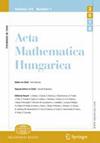不可数哈德维格猜想和用图描述树的特征
IF 0.6
3区 数学
Q3 MATHEMATICS
引用次数: 0
摘要
我们证明了大小为 \(\lambda\)的非特殊树的存在等价于大小为 \(\lambda\)的没有 \(K_{\omega1}\) minor 的不可数色度图的存在,从而建立了特殊树数与不可数哈德维格猜想之间的联系。此外,还利用图推导出了阿伦扎恩树、库雷帕树和苏斯林树的特征。我们引入了一个新的广义图连通性概念,利用这个概念,我们能够描述弱紧凑红心。本文章由计算机程序翻译,如有差异,请以英文原文为准。
The uncountable Hadwiger conjecture and characterizations of trees using graphs
We prove that the existence of a non-special tree of size \(\lambda\) is equivalent to the existence of an uncountably chromatic graph with no \(K_{\omega1}\) minor of size \(\lambda\), establishing a connection between the special tree number and the uncountable Hadwiger conjecture. Also characterizations of Aronszajn, Kurepa and Suslin trees using graphs are deduced. A new generalized notion of connectedness for graphs is introduced using which we are able to characterize weakly compact cardinals.
求助全文
通过发布文献求助,成功后即可免费获取论文全文。
去求助
来源期刊
CiteScore
1.50
自引率
11.10%
发文量
77
审稿时长
4-8 weeks
期刊介绍:
Acta Mathematica Hungarica is devoted to publishing research articles of top quality in all areas of pure and applied mathematics as well as in theoretical computer science. The journal is published yearly in three volumes (two issues per volume, in total 6 issues) in both print and electronic formats. Acta Mathematica Hungarica (formerly Acta Mathematica Academiae Scientiarum Hungaricae) was founded in 1950 by the Hungarian Academy of Sciences.

 求助内容:
求助内容: 应助结果提醒方式:
应助结果提醒方式:


